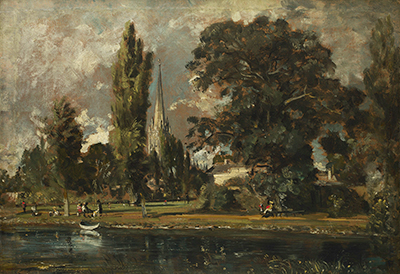This painting was done when Romanticism was at its best. This movement relied on individuals as emotive beings to derive artistic motivation. John Constable did the Salisbury Cathedral and Leadenhall from the River Avon using his landscape experience. This is credited to his association with Thomas Gainsborough, who was at that time an authority in the field.
However, John's approach was different as he relied on nature for inspiration, as opposed to classical imagination. The painting was done in 1820 on canvas using oil. It showed River Avon in the foreground, with the Salisbury Cathedral and the Leadenhall in the background. There is a path along the river where people are seen going about their daily routine. The trees in the middle which partly hides the cathedral orients the ambience of the atmosphere, and acts as resting places for the people within the vicinity.
The romanticism is evident in the picture through the medieval architecture of the Leadenhall and the Salisbury Cathedral. The boat on the shore of the River adds to the plot. The painting represents an actual place with features and amenities. It strengthens John's believe in natural inspiration for his painting. His attention to details and graphic representation gave life to his work. The painting is currently housed and owned by the National Gallery in London. He was a student of John Thomas Smith and Claude Lorrain who taught him professional fine art. He also got artistic education from the Royal Academy Schools where he was inspired by the works of Thomas Gainsborough, Annibale Carracci, Jacob van Ruisdael and Peter Paul Rubens. It is here that he became a master in landscape painting.
Among his famous works include the Salisbury Cathedral from the Bishop's Ground (1825), The Hay Wain (1821), Wivenhoe Park (1816), Dedham Vale (1802), The Opening of the Waterloo Bridge (1817) and the Quarters behind Alresford Hall (1816). Most of John's works have received traction in France more than his home country, producing contemporary painters like Theodore Gericault and Eugene Delacroix. It was also the artistic model used in the Barbizon School and is widely quoted by the 19th Century French Impressionists.




